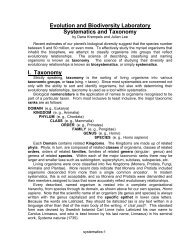Evolution and Biodiversity Laboratory Systematics and Taxonomy
Evolution and Biodiversity Laboratory Systematics and Taxonomy
Evolution and Biodiversity Laboratory Systematics and Taxonomy
You also want an ePaper? Increase the reach of your titles
YUMPU automatically turns print PDFs into web optimized ePapers that Google loves.
they are symplesiomorphies with respect to primates only. In other words, these threecharacters will not help you to determine which primates are your closest relatives. Todo that, we must find more unique derived characters. Here goes.List two derived characteristics shared by all great apes (Hominidae, of which youare a member), but not shared by other primates. Again, you might have to do somesearching. Notice that it can become more <strong>and</strong> more difficult to find synapomorphieslinking particular taxa as they become smaller/less inclusive.1.2.Finally, list as many derived characters as possible that make Homo sapiensdifferent from all other great apes. Be sure to restrict your list to truly BIOLOGICALcharacters--not cultural ones. (This is where it gets really challenging, <strong>and</strong> sometimesthere is simply not a clear line to draw, especially where cultural influences ("nurture")interact with a truly genetic <strong>and</strong> heritable ("nature") character.)1.2.3.4.5.As you can see, it is not a simple task to find biological characteristics that trulyseparate Homo sapiens from other species of great apes. In fact, we share more than99% of our DNA with our closest ape relatives, the Common Chimpanzees (Pantroglodytes) <strong>and</strong> Bonobos (Pan paniscus).Take a look back at the several lists you have made, <strong>and</strong> note how synapomorphiesidentified at higher <strong>and</strong> higher resolutions help us to determine most recent commonancestry among the various taxa. Systematists use this method to construct <strong>and</strong> revisephylogenies for all living things.3. Homologous vs. Analogous charactersIf the similarity between two characters in two separate taxa can be attributed totheir presence in a common ancestor, then those two characters are said to behomologous. For example, the forelimb bones of all tetrapod (four-legged) vertebratesare homologous to one another, because they all evolved from the same bones in acommon tetrapod ancestor. Although the bones may have evolved very different sizes,shapes, <strong>and</strong> functions, they all developed from the same embryonic sources <strong>and</strong> haveevolved from the same ancestral tetrapod limb bones.List five homologous characters you share with all other vertebrates that perform asimilar function in you <strong>and</strong> all other vertebrates:1.2.3.4.5.systematics-8

















